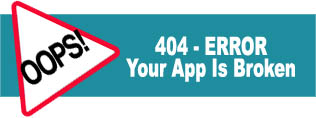Or… How not to succeed on the Internet
According to a recent Inc. magazine article on How to Position Your Business for Success, One of the top three recommendations is: Increase and improve your online presence
Did you know? 95% of Websites NEVER even pay for the cost to develop them. WHY?
The simple answer is…NOT fully utilizing the Internet – NOT understanding the purpose of a website – LOSING out on opportunities that your competition is getting, right now.
Ask yourself if your site is guilty of one of these common website mistakes:
 Mistake 1: No Internet Strategy. Unclear goals, Unrealistic expectations, No plan, Not researching competitors BEFORE building your website. Not identifying the benefits of your products or services.
Mistake 1: No Internet Strategy. Unclear goals, Unrealistic expectations, No plan, Not researching competitors BEFORE building your website. Not identifying the benefits of your products or services.
People want to know how your products and services will help them. Sell the SIZZLE not the STEAK! The first step is to establish your objectives and identify your target audience. Remember: Your site needs to reflect your unique style and message.
Mistake 2: Putting form before function. Don’t allow the bells and whistles to get in the way of the actual purpose of the site. Don’t sacrifice functionality for cuteness. Flash intros usually do nothing but annoy visitors. Unnecessary music played on the home page, annoying pop-up ads, etc. Remember users don’t care about technology they just want quality in the basics.
Better marketing will contribute more to your website’s business goals than any new technology.
Anytime you feel tempted to add a new feature or advanced technology to your site, first consider whether you would get a higher ROI by spending the resources on promoting what you already have.
Mistake 3: Having features that don’t work properly. If you are going to add features make sure you, rather than your customers, periodically test them.
 Common annoying features include: typos, slow downloading, broken links, under construction signs, visible counters, outdated information, overuse of colors and fonts, confusing navigation, information hidden away and difficult to find.
Common annoying features include: typos, slow downloading, broken links, under construction signs, visible counters, outdated information, overuse of colors and fonts, confusing navigation, information hidden away and difficult to find.
Mistake 4: Not identifying who you are and what you do. A website should quickly convey the type of business you are in and the products and services you offer. Sounds like a no-brainer? Many small business websites leave you looking while pondering, “What do these guys do?”
Always include phone numbers and email. Having a physical mailing address on the site is mandatory if you are selling on your site. A company with no address is not one you want to give money to.
Your Home page should include a Keyword Relevant title that answers the Who, What, Where, When, Why and How questions about your business. It is a good idea to emphasize what you do with a photo or graphic that makes it clear.
Mistake 5: Ineffective content. Writing for the Internet means content should first and foremost answer users’ questions. Web content should be SHORT, SCANNABLE, TO THE POINT (rather than full of fluffy marketing slogans). If content leaves users unclear of what to do, or if there’s too much of it, or it’s full of jargon, or it’s difficult to find what they want, they’ll move on!
Emphasize how your site offers VALUE to visitors and how your services DIFFER from those of key competitors. If you cannot define your Unique Selling Proposition in 30 seconds or less, then you cannot effectively communicate it on your website.
Remember: when users are searching, they only scan a site for 8 seconds on average to determine if the site is worth their time.
Content Tips:
– Avoid Passive verbs. Use active verbs that are powerful and lend energy to your site.
– Avoid Long sentences. Better keep it short and simple so it can easily be retained.
– Avoid Lengthy pages. Internet users tend to scan, so adjust to their attention span. If you have a lot to say, create a series of pages with good navigation to explain your topics.
– Include a Call To Action. Do not neglect asking visitors to do something. Include a space designated to tell your visitors what you want them to do next. Sign up for my newsletter. Order now.
 Mistake 6: Not marketing your website. Also called the “if you build it, they will .com” delusion. A common small business mistake is to assume that customers will start flocking to your site without promoting it. That’s like printing a brochure and then not distributing it!
Mistake 6: Not marketing your website. Also called the “if you build it, they will .com” delusion. A common small business mistake is to assume that customers will start flocking to your site without promoting it. That’s like printing a brochure and then not distributing it!
Building your website is the FIRST step, not the only step in a successful Internet Marketing Plan.
Website Marketing Tips:
– Optimize for effective Search Engine listings. Include Meta Tags and focus on keyword searchable content. Websites that are done primarily in graphics are difficult for search engines to index.
– Integrate your website with other marketing activities, tell customers and the community about it
– Offer incentives to visit the site. Free information or discounts. Put the offer on your business card.
– Encourage and reward other businesses for sending you online customers.
– Start building your email database. Consider an e-newsletter to keep you in front of your prospects on a regular basis.
Mistake 7: Inadequately measuring RESULTS. Many sites overlook the bottom-line impact when calculating their websites’ ROI. You can’t improve your results if you aren’t sure what they are.
A key advantage of a website is the amount of visitor statistical information it can provide you about your customers and prospect’s actions, behavior and response to your web site. It can also help you to track search engine rankings and even the effectiveness of your Print, TV and Radio advertisements.
The simple Internet success formula is:
RESEARCH – TEST – MEASURE – ADJUST – RETEST – REPEAT TO INFINITY
For more information or to request a FREE Website Analysis
Contact the Internet Marketing Experts:
Amazeinc Internet Solution Providers
760-754-8012 – info@amazeinc.com – www.amazeinc.com
